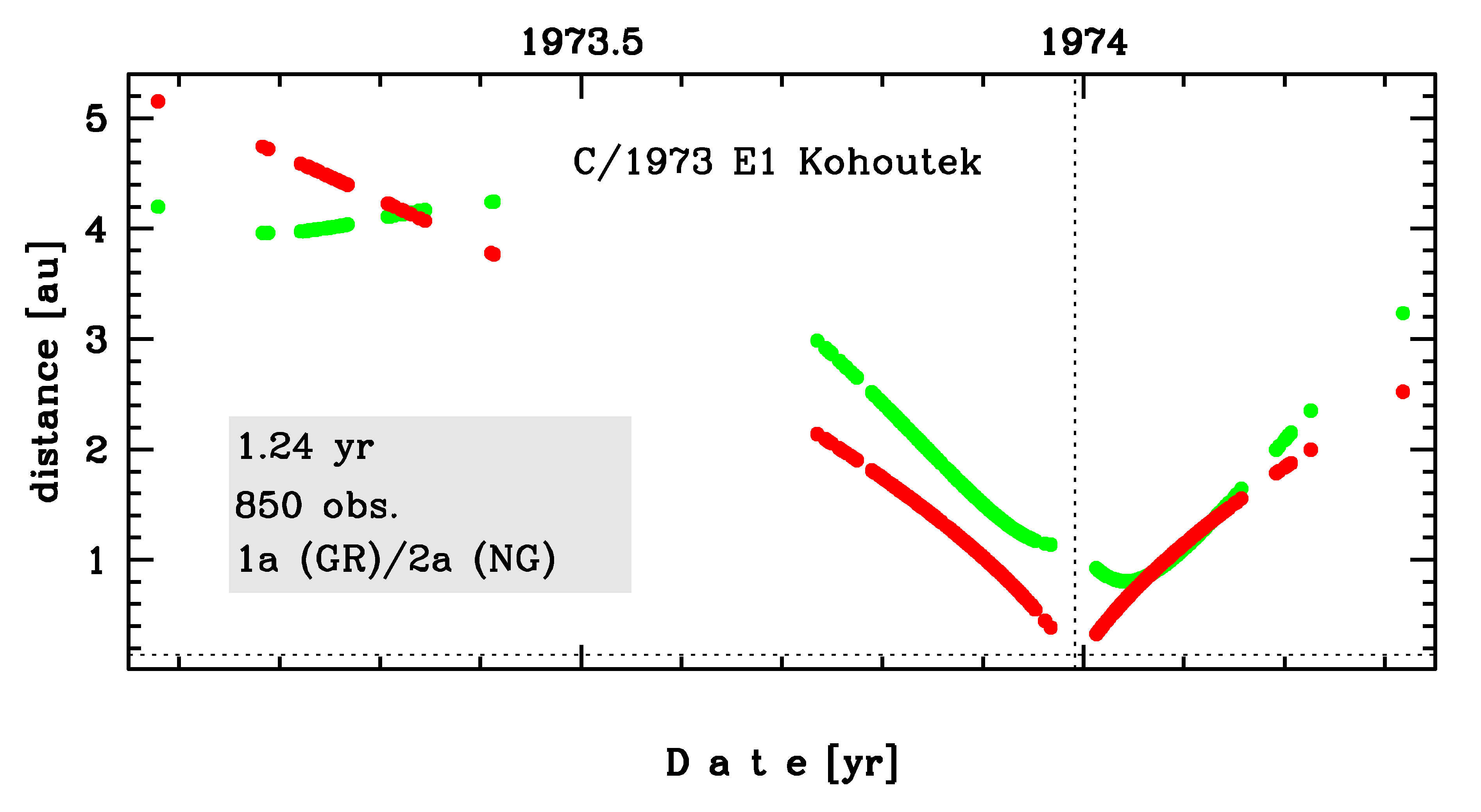C/1973 E1 Kohoutek
more info
Comet C/1973 E1 was discovered on 7 March 1973 by Luboš Kohoutek (Hamburg Observatory, Bergerdorf, Germany), that is 9 months and 3 weeks before its perihelion passage.Later, a prediscovery observation was found taken on 28 January at the same place. This comet was observed until 10 November 1974 [Kronk, Cometography: Volume 5].
Comet had its closest approach to the Earth on 15 January 1974 (0.806 au), 2.5 weeks after its perihelion passage.
Solution given here is based on data spanning over 1.24 yr in a range of heliocentric distances: 5.15 au – 0.142 au (perihelion) – 2.52 au.
This Oort spike comet suffers rather small planetary perturbations during its passage through the planetary system; these perturbations lead to a more tight future orbit with semimajor axis of about 1,700 au.
See also Królikowska 2020.
Comet had its closest approach to the Earth on 15 January 1974 (0.806 au), 2.5 weeks after its perihelion passage.
Solution given here is based on data spanning over 1.24 yr in a range of heliocentric distances: 5.15 au – 0.142 au (perihelion) – 2.52 au.
This Oort spike comet suffers rather small planetary perturbations during its passage through the planetary system; these perturbations lead to a more tight future orbit with semimajor axis of about 1,700 au.
See also Królikowska 2020.
| solution description | ||
|---|---|---|
| number of observations | 850 | |
| data interval | 1973 01 28 – 1974 04 26 | |
| data type | perihelion within the observation arc (FULL) | |
| data arc selection | entire data set (STD) | |
| range of heliocentric distances | 5.15 au – 0.14 au (perihelion) – 2.52 au | |
| detectability of NG effects in the comet's motion | comet with determinable NG~orbit | |
| type of model of motion | GR - gravitational orbit | |
| data weighting | YES | |
| number of residuals | 1690 | |
| RMS [arcseconds] | 1.36 | |
| orbit quality class | 1a | |
| previous orbit statistics, both Galactic and stellar perturbations were taken into account | ||
|---|---|---|
| no. of returning VCs in the swarm | 4704 | * |
| no. of escaping VCs in the swarm | 297 | |
| no. of hyperbolas among escaping VCs in the swarm | 0 | |
| previous reciprocal semi-major axis [10-6 au-1] | 17.77 – 20.13 – 22.80 | R |
| previous perihelion distance [au] | 230 – 510 – 710 | R |
| previous aphelion distance [103 au] | 87 – 99 – 110 | R |
| time interval to previous perihelion [Myr] | 9.1 – 11 – 13 | R |
| percentage of VCs with qprev > 20 | 100 | |
| previous_g orbit statistics, here only the Galactic tide has been included | ||
|---|---|---|
| no. of returning VCs in the swarm | 4605 | * |
| no. of escaping VCs in the swarm | 396 | |
| no. of hyperbolas among escaping VCs in the swarm | 0 | |
| previous reciprocal semi-major axis [10-6 au-1] | 17.93 – 20.33 – 23.12 | R |
| previous perihelion distance [au] | 81 – 190 – 420 | R |
| previous aphelion distance [103 au] | 86 – 98 – 110 | R |
| time interval to previous perihelion [Myr] | 9 – 11 – 13 | R |
| percentage of VCs with qprev > 20 | 100 | |
